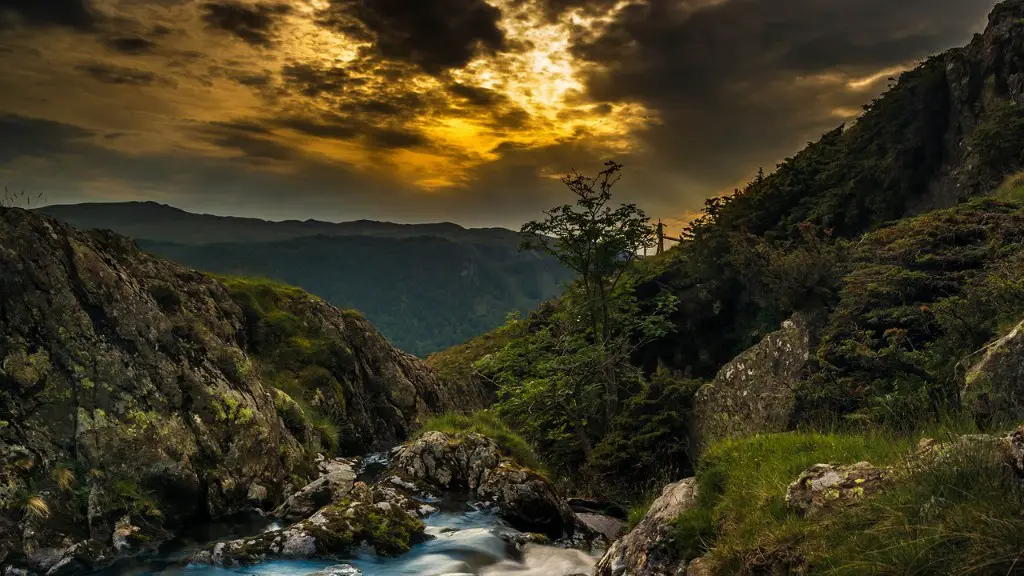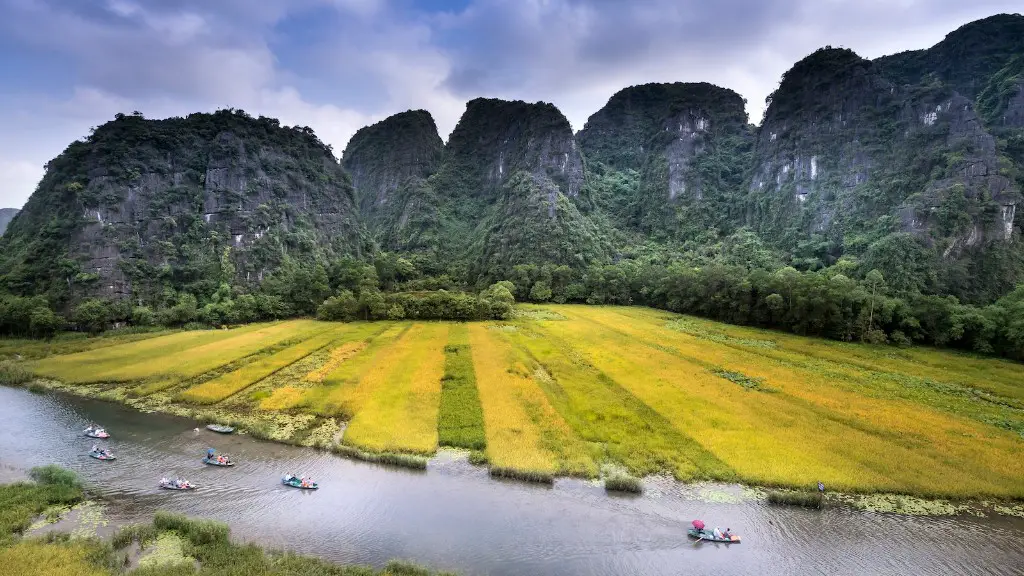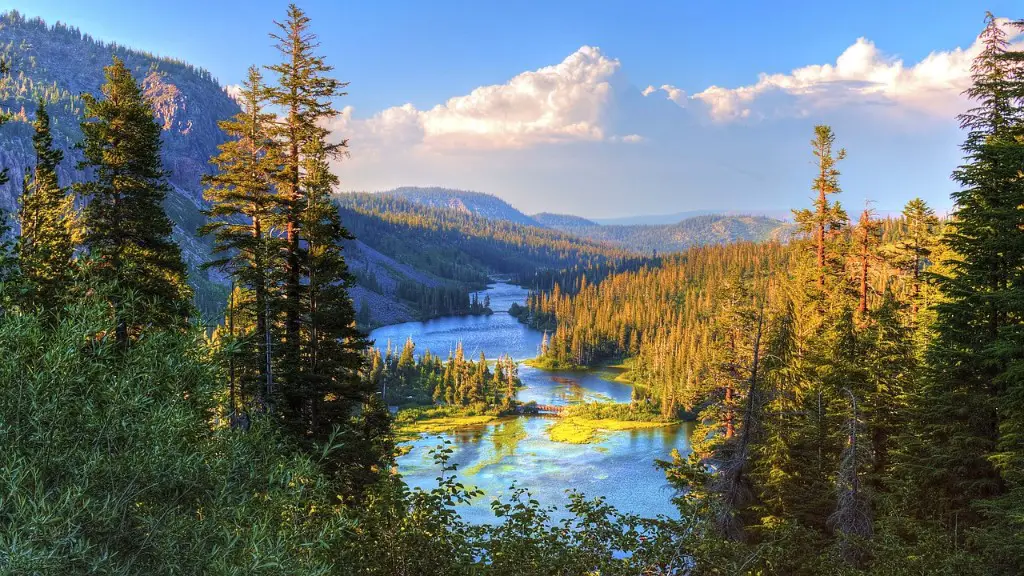The Yangtze River is the longest running river in Asia, spanning over 6,300 kilometers. Originating in the central mountains of Tibet, it flows through the southeastern region of China before emptying into the East China Sea. But how did the Yangtze River come to be? By understanding the geological and climatic events that shaped its formation, we can gain insight into how it all began.
The Yangtze’s formation began millions of years ago, in a period known as the Quaternary glaciation. As the Earth cooled and glaciers advanced and retreated over the course of several ice ages, the area now occupied by the Yangtze basin was shaped. Glaciers scoured the earth, moving and eroding rocks, and redirecting the flow of rivers. This is why – when examining a map of the Yangtze basin – we can see that its deep gorges wind and meander in sweeping curves, evidence of glaciers’ effect on erosion and sedimentary deposition. As the ice melted, the Yangtze’s main flow and its many tributaries formed, fed by myriad smaller rivers and streams.
The hydrological processes involved with Yangtze’s formation have been studied extensively by experts. According to their findings, some of the Yangtze’s smallest tributaries were fed by atmospheric processes such as katabatic winds, which created orographic precipitation, where masses of humid air are forced to cool as they rise, condensing and forming rainfall. This kind of precipitation especially aids in the formation of smaller rivers. The geographic and climatic region of China in general is also responsible for the creation of vast river networks, as the humid climate led to precipitation and subsequent water flow.
In more recent centuries, human activity has altered the Yangtze in a number of ways. Construction of immense dams and water control systems has caused significant changes in the water depth, flow rate, and sedimentation of the river and its tributaries. Channelization has widened the main flow of the Yangtze and disrupted the dynamics of its tributaries, while unsustainable fishing and agricultural practices have threatened aquatic lifeforms. One of the more controversial projects managed by the Chinese government has been the South-North Water Transfer Project, which is meant to redistribute water from the Yangtze in order to alleviate water shortages in the country’s alluvial plains.
The Yangtze River is a complex system and what we know about its formation is still developing. Yet, by understanding the geological and climatic events that shaped it, we can better appreciate the scale and magnitude of the river, and the region it calls home.
Climatic Influence in the Formation of Yangtze
The Yangtze River basin is estimated to have been established anywhere from ten to thirty million years ago. According to experts, in the four million years preceding the Quaternary glaciation, the continent of Asia was affected by monsoonal climates, with polar latitude spells affecting the glaciers and constantly changing the area’s relief. This phenomenon has had an enormous impact on the shape of the present-day Yangtze basin, with various regions containing significant sediment accumulations left by the glaciers.
A common trend in the area over this four million year period was an ever-present notion of glacio-eustatic fluctuations, resulting in changes in sea level, a surplus of precipitation and a consequent abundance of running water across the continent of Asia. As the climate cooled and the relief of the land changed in these periods, rivers were created and transported sediment particles from the mountains and Tibetan Plateau in the west to the regions surrounding the East China Sea.
Since it began to flow, the Yangtze’s many morphological characteristics have been determined by glacial–fluvial processes, resulting in a vast array of deltaic lobes and other formations, whose geometries and dimensions are determined by sedimentary and tectonic movements.
This combination of hydrogeological and geological events, on one side, and the presence of climatic elements, on the other, has shaped the Yangtze River and its basin over the course of its long and complex history.
Himalayan Uplift and Yangtze Formation
Uplift of the Tibetan Plateau and the Himalayas has been widely accepted by experts as one of the main mechanisms behind the formation of the Yangtze River. This is what is known as the ‘geodynamic-orogenic process’, which caused the uplift of the basins west of the river and precipitated the eventual formation of the Yangtze.
The break-up of the Asian continent led to a change in the geotectonic structure of the area, and the formation of a series of faults, causing the uplift of Tibet. At the same time, block uplift of the basins caused the erosion of major rivers, whose channels deepened and lengthened, eventually forming the major river systems running through present-day China.
This uplift created the conditions necessary for the formation of the Yangtze, allowing sediment entrainment and the laying down of deposits that form the topography of the river basin. According to experts, without the break-up of the Asian continent and the ensuing Tibetan uplift, the Yangtze River would not have formed in its present-day state.
Geological Activity and the Yangtze Formation
A series of geological and hydrological events is accepted by experts to have been responsible for the formation of the Yangtze River, with different mechanisms operating at different times. The main stages of the river’s formation include the uplift of the Tibetan Plateau, the climate-controlled glaciological process, and the more recent human activity.
Firstly, the break-up of the Asian continent, which could have been caused by a shift in the earth’s mantle, created the conditions necessary for the eventual formation of the Yangtze. This event, as mentioned earlier, was responsible for the uplift of the basins west of the river and the consequent erosion and sedimentary deposition of the Tibetan Plateau.
Secondly, the Quaternary glaciation and its successive ice ages, with temperatures varying from as low as -18°C to as high as +6°C, played a major role in shaping the surface geography of the area, carving valleys and redistributing sedimentary material. This left the area that is now occupied by the Yangtze basin with a shallow path, and through its movement, the river’s main flow was formed.
Lastly, over the centuries, human activity has changed the dynamics of the Yangtze River. Although much of the landscape remains unchanged, large scale engineering works and unsustainable resource extraction techniques have had a major impact on the environment and aquatic ecology of the region.
Impact of Human Action on Yangtze Formation
As the world’s third longest river, the Yangtze has been inextricably linked with the regions through which it runs for thousands of years, more recently with the rise of the Chinese civilization in the past couple of centuries. This has become even more evident with the advent of industrialization and the consequent need for resources.
During the 20th century, vast engineering projects have been conducted in order to regulate the river’s flow. These are primarily aimed at controlling flooding, mitigating the impact of snowmelt, and harnessing hydropower from the river. For example, the large dams along the river’s course, such as the Three Gorges Dam, the Gezhouba Dam, and the Xiluodu Dam, are part of the Chinese government’s decades-long effort to tame the Yangtze and turn it into an increasingly reliable source of power.
Moreover, human activity has had a detrimental effect on the ecology and biodiversity of the Yangtze. Pollution has impacted water quality, and unsustainable fishing practices have led to a decrease in the population of endangered fish species. In addition, the sediment load of the Yangtze has increased due to the construction of dams, which has caused the river’s delta to sink below sea level, resulting in increased erosion levels.
The combined effects of human intervention have led experts to conclude that the river’s- and its basin’s-formation will continue to be affected into the distant future. In the end, this means that our actions will determine the fate of the Yangtze River, as well as its environment.
The Future of Yangtze Formation
The impact of human interference in the formation of the Yangtze is clear, with its hydrological, geological, and hydrological processes being altered by decades of engineering and resource extraction. Yet, consensus regarding the future of the river varies, with experts providing conflicting predictions.
On one hand, some experts argue that large scale infrastructural interventions may be necessary in order to prevent flooding and harness energy from the river, as well as protect areas vulnerable to annual inundations. Furthermore, efficient water management systems need to be enforced in order to preserve the river’s stability and preserve its aquatic life.
On the other hand, there are experts who argue that the Yangtze should be left alone, and its hydrological, geomorphological, and ecological processes should be free to take their natural course. These experts point out that any disruption of the river’s dynamics may have unpredictable environmental consequences, disrupting the already precarious ecological balance in the area.
In the end, our understanding of the Yangtze River’s formation is insufficient and constantly evolving, and the question of its future remains open, awaiting the definitive answer informed by our capacity to better understand the river and its environment.





